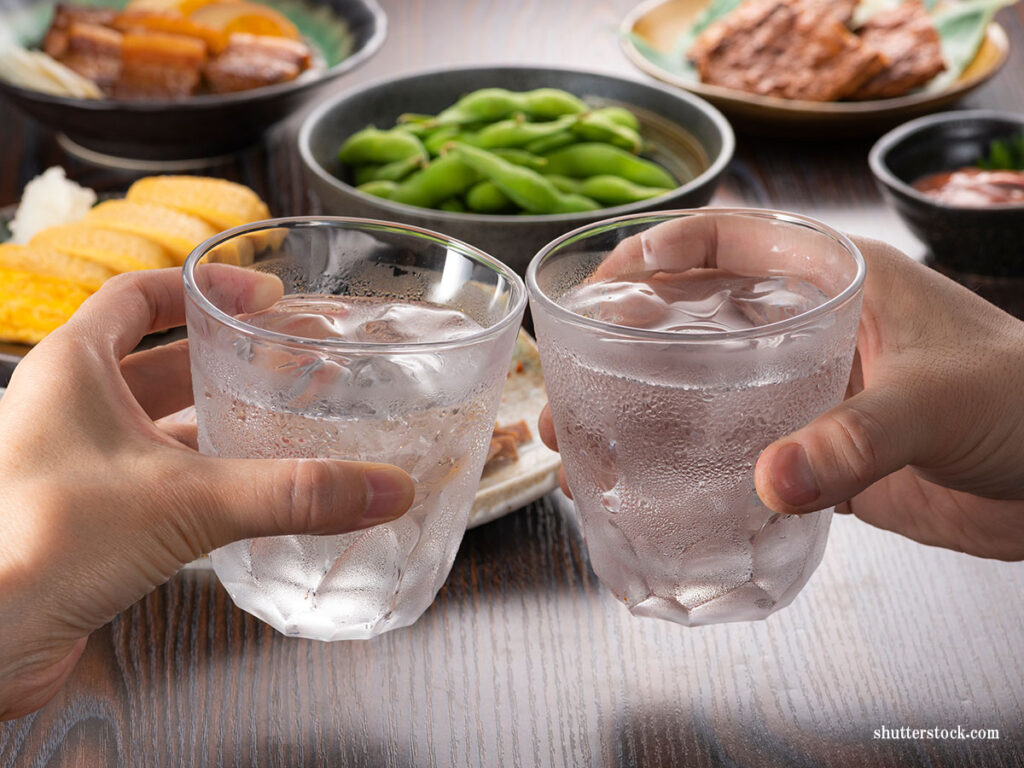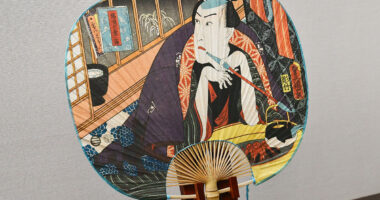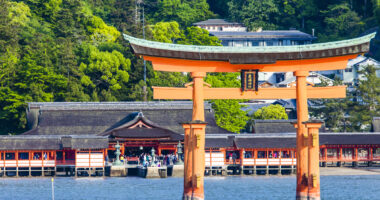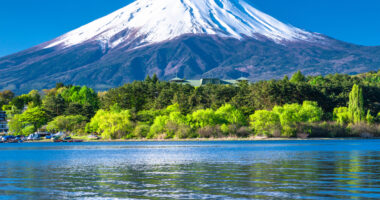If you’re visiting Japan, one experience not to miss is tasting its traditional alcoholic beverages — time-honored drinks that have been loved by locals for generations.
There’s a wide variety of alcohol rooted in different regions and climates—some brands are available nationwide, while others are rare finds only available locally.
From sake and shōchū to awamori (an Okinawan distilled spirit made from rice), each type has its own ingredients, production methods, and distinct flavor profiles. Alcohol content also varies widely, ranging from drinks around 10% to stronger varieties exceeding 30%, offering something for every palate.
Japanese sake
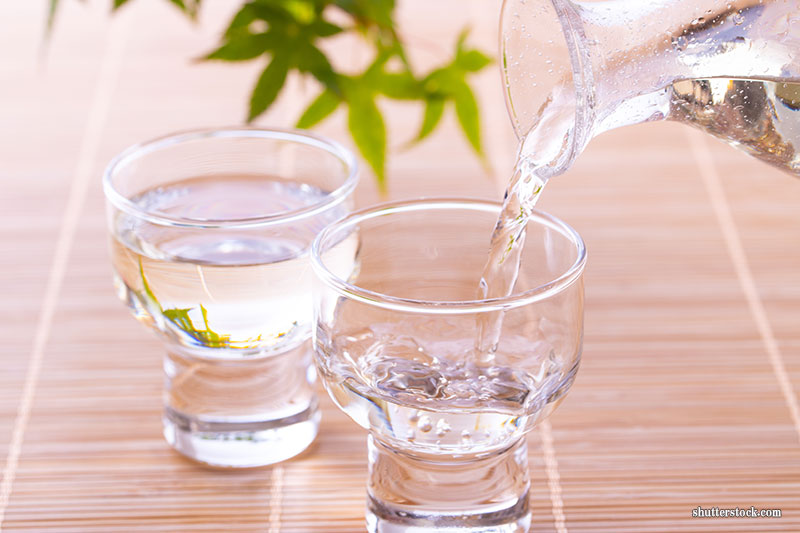
Japanese sake
Sake, called nihonshu in Japanese, is perhaps the first type of alcohol that comes to mind when thinking of Japan. Made from rice, water, and kōji (a beneficial grain culture), sake has long been a part of daily life in Japan.
It’s widely enjoyed throughout the country and can be found not only in restaurants but also in convenience stores and supermarkets, making it easy to enjoy casually.
However, sake also varies in character depending on the region, with some limited-edition varieties available only in the areas where they’re produced. Traveling in search of these locally brewed sake—known as jizake—is a delicious and rewarding way to experience Japan.
Sake also changes with the seasons. In winter, you’ll find shinshu (new sake) made from freshly harvested rice, offering a crisp, refreshing flavor.
In summer, natsuzake (summer sake) with a clean, refreshing finish is especially popular—best served well-chilled. One of the great pleasures of Japanese sake is being able to experience the seasons through all five senses.
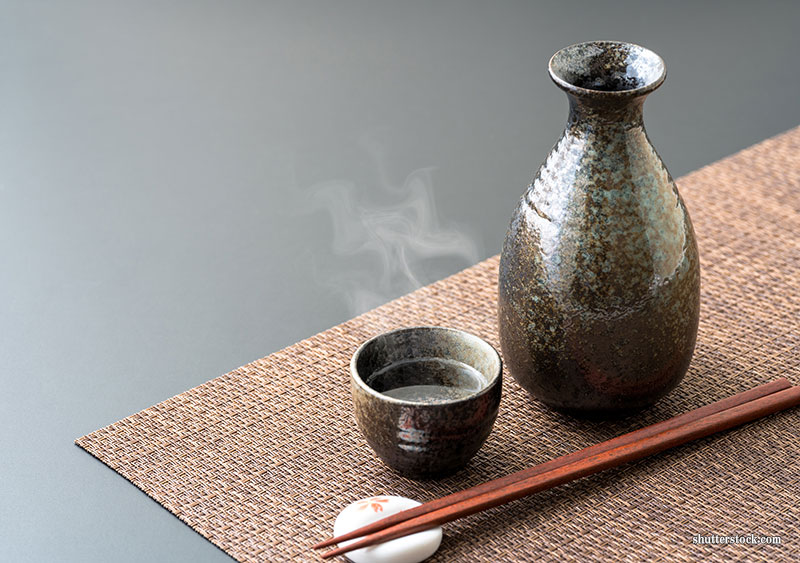
Hot Japanese sake
Alcohol content: around 13-16%
With a moderate alcohol content, it’s easy to enjoy as a drink with meals—not only with Japanese food, but also Western cuisine. It pairs well with everything from sashimi and sushi to fried dishes, regardless of genre.
However, be careful not to overdrink. Sipping water alongside sake can help prevent becoming overly intoxicated.
How to drink Japanese sake
The flavor of sake can change significantly depending on its temperature. When served chilled, it offers a clean, refreshing finish—perfect as a meal accompaniment during the warmer months.
At room temperature, it has a smooth mouthfeel with a well-balanced flavor profile.
In the cold of winter, warm sake—known as atsukan—is especially recommended. Heating it enhances the sweetness and umami of the rice, while also warming the body.
Shochu
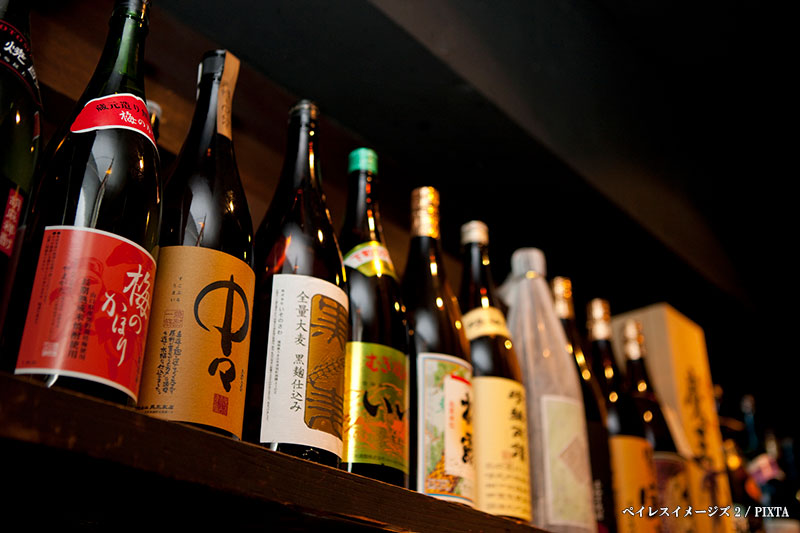
Shochu
Alongside sake, one of Japan’s other iconic traditional alcoholic beverages is shochu.
A type of distilled liquor, shochu typically has a slightly higher alcohol content and is known for its clean, crisp finish. It’s especially popular in southern Japan, particularly in Kyūshū, where it’s a part of everyday life.
What makes shochu so appealing is how dramatically its flavor changes depending on the ingredients used.
It can be made from a wide variety of base ingredients, such as sweet potatoes, barley, rice, brown sugar, buckwheat, or even chestnuts—each resulting in a distinct aroma and taste.
Take imo-jōchū (sweet potato shochu), for example: it’s known for its rich, roasted fragrance. Mugi-jōchū (barley shochu) has a light finish and is easy to drink, making it a good choice for shochu beginners.
There’s even a special type of brown sugar shochu, known as kokutō shōchū, that can only be produced in the Amami Islands. It offers a gentle sweetness and a smooth flavor profile.
Another nice feature of shochu is its versatility—you can enjoy it on the rocks, diluted with water (cold or hot), or mixed with soda, depending on your preference or the season.
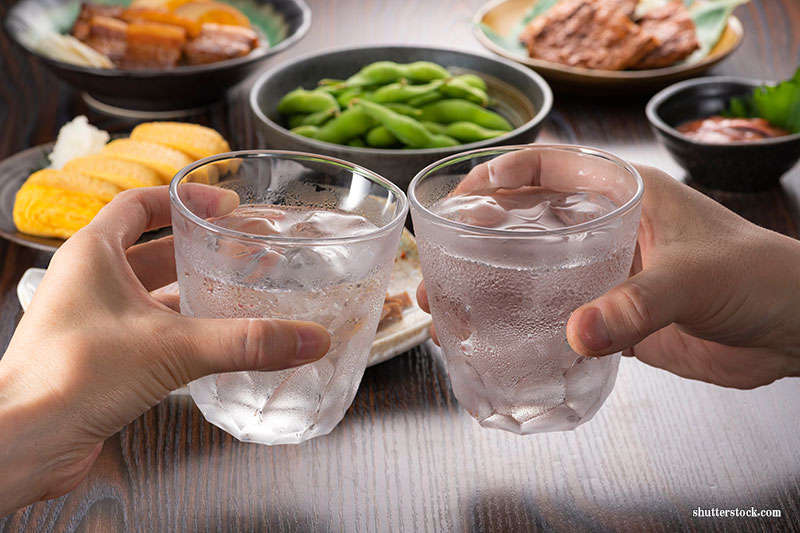
Shochu on the rocks
In particular, drinking it with hot water in the colder months really brings out the aroma of the shochu, gently warming you.
In recent years, the number of premium shochu varieties with rich aromas and stylish, modern bottles for overseas markets has grown—drawing increasing attention from international tourists.
Alcohol content: around 25-30%
Some types of shochu have an alcohol content in the low 20% range, but overall, it’s slightly stronger than sake. Barley shochu is also used in drinks like chūhai (shochu highballs).
When mixed with soda or water, it can go down surprisingly smoothly—so be careful not to overdrink.
How to drink shochu
Recommended ways to enjoy shochu depend on the ingredients of the variety you’re drinking.
Rice shochu’s mild, refined aroma makes it ideal served on the rocks or diluted with water.
With its toasty, light flavor, barley shochu is often enjoyed mixed with soda water. Meanwhile, sweet potato shochu’s rich, sweet taste typically lends itself to being served on the rocks or with hot water.
If you’re new to shochu, it’s a good idea to start by trying it with water or soda.
Awamori
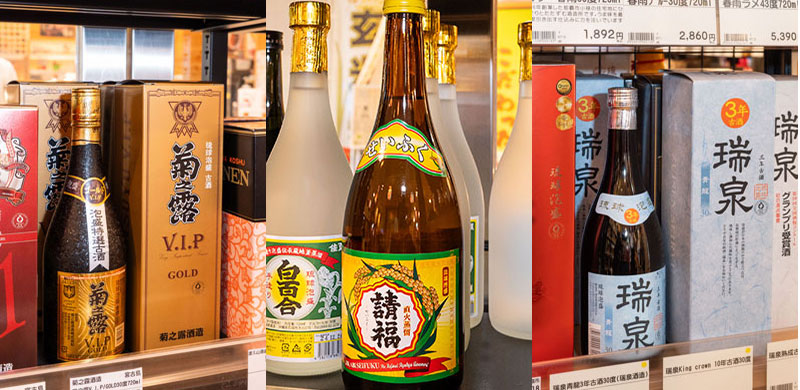
Example of awamori sold at Ginza Washita Shop Honten
If you visit Okinawa, be sure to try awamori. Produced in Japan’s southernmost islands, this traditional spirit is said to be the oldest distilled liquor in the country.
Made primarily from Thai rice and kuro kōji (a type of beneficial grain culture), awamori is known for its bold aroma and strong, rich flavor.
Freshly brewed awamori has a slightly dry taste and a unique, memorable fragrance. It’s commonly enjoyed on the rocks or diluted with water, but mixing it with soda is also a great way to enjoy a light and refreshing drink.
With an alcohol content of around 25–30%, awamori is on the stronger side—but depending on how how it’s served, it can be surprisingly smooth and easy to enjoy.
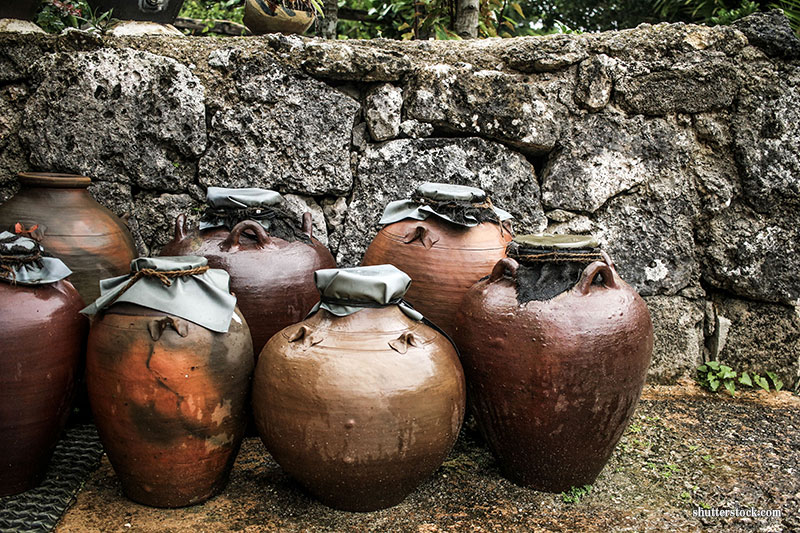
Kusu
One of the highlights of awamori is kūsu (aged awamori). Awamori becomes mellower in taste and calmer in aroma the longer it is aged.
Those aged for three years or more are designated as kusu, with some varieties matured for 10, 20 years, or even longer.
Kusu has a smoother texture with the sharp edges of alcohol mellowed out, making it highly recommended for beginners.
Note that the alcohol content of kusu tends to be higher, around 30–40%. The longer the aging, the deeper the balance of aroma and richness.
Alcohol content: (awamori) around 25–30%, (kusu) around 30–40%
Regular awamori has a slightly higher alcohol content than sake or wine but becomes easier to enjoy when diluted with water or soda. Kusu is even stronger, at around 30–40%, and is best savored straight or on the rocks.
How to drink awamori
Awamori has a high alcohol content, and to fully enjoy its rich flavor, it’s typically served on the rocks. However, if you prefer a refreshing aftertaste, mixing it with soda is also popular—especially perfect for the hot season in Japan.
Kusu, meanwhile, is known for its mellow and deep flavor, making it ideal to savor straight or on the rocks. It’s recommended to enjoy it slowly while appreciating its aroma.
Habushu
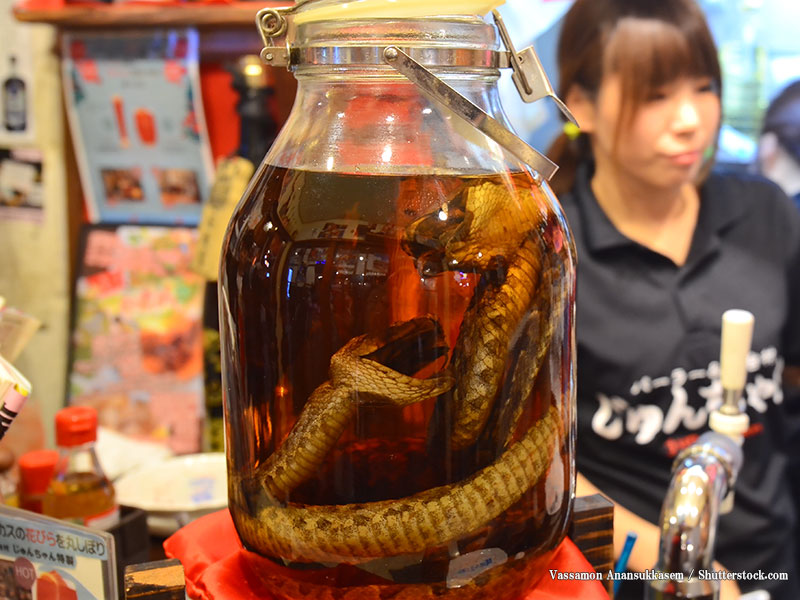
Habushu
After enjoying the rich flavors of awamori and kusu, be sure to check out another uniquely Okinawan spirit—habushu
Habushu is deeply tied to Okinawan traditional culture and is made by soaking a habu snake (a venomous pit viper) in awamori. Because it uses high-proof awamori as its base, it has a powerful, punchy flavor.
Its distinctive taste comes from the combination of the awamori and components extracted from the habu, and it has long been consumed for its supposed health benefits, such as boosting stamina and supporting overall wellness—similar to medicinal herbal liquors.
Habushu is also considered a special souvenir or a symbol of good health and fortune, and since it’s rarely found outside of Okinawa, it’s regarded as a rare and unique spirit.
Alcohol content: 30-40%
Since awamori is the base, habushu has a very high alcohol content, so it’s best enjoyed in small amounts. Bearing its reputation for fostering vitality and good fortune, it’s also a good idea to take your time to savor both its flavor and cultural significance.
How to drink habushu
Due to its high alcohol content, habushu is typically sipped in small shots.
It can also be enjoyed on the rocks with ice, but if you’d like to mellow the intensity, try mixing it with soda water or tonic.
Since it’s also seen as a type of medicinal liquor, it’s best to enjoy it slowly and in a way that suits your condition or mood.
Umeshu and other Japanese fruit liqueurs
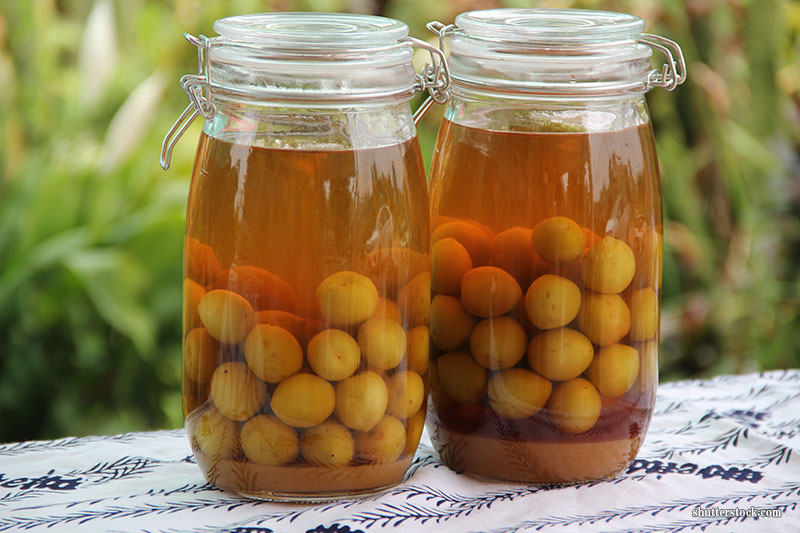
Umeshu
Umeshu (Japanese plum wine) is a sweet, easy-to-drink traditional Japanese fruit liqueur beloved by people of all ages.
It’s made by steeping unripe, green-skinned ume plums in rock sugar and shochu or sake, allowing the flavors to develop slowly over the course of several months to several years.
It’s also commonly homemade and has long been cherished as a seasonal tradition in early summer.
The appeal of umeshu lies in its sweet-tart flavor and mellow mouthfeel. It’s perfect as an aperitif or dessert drink, adding a gentle touch to any dining occasion.
In addition to umeshu, Japan boasts a wide variety of other fruit liqueurs. Popular examples include liqueurs made from yuzu citrus or apricots, each offering a unique expression of the fruit’s aroma and flavor.
Many of these fruit liqueurs feature regional specialties and are available in limited editions, making them popular souvenirs as well.
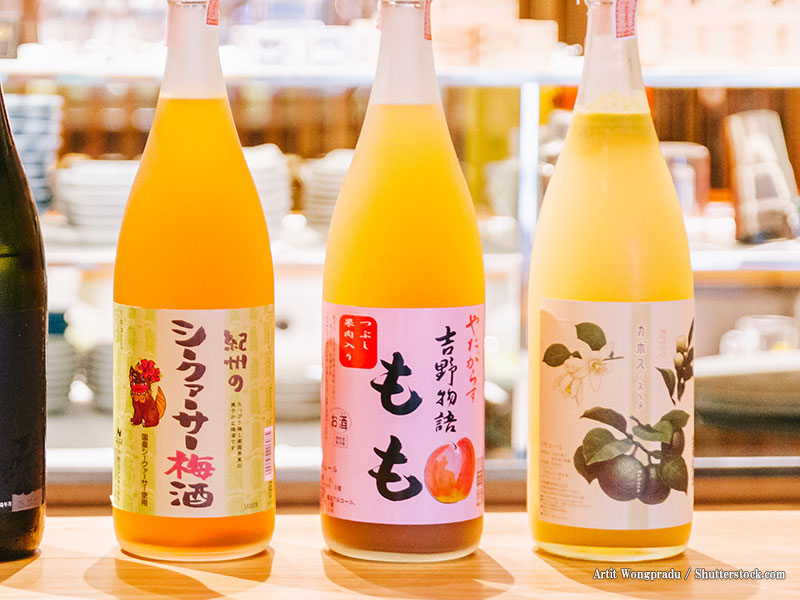
Japanese fruit liqueurs
Alcohol content: 10-15%
Fruit liqueurs like umeshu are sweet and mild in flavor, making them easy to enjoy even for beginners who aren’t used to drinking alcohol.
They can be enjoyed in a variety of ways depending on the season or your mood—on the rocks or with soda for a refreshing taste, or served warm with hot water for a cozier experience.
How to drink umeshu and other Japanese fruit liqueurs
Since umeshu and other fruit liqueurs are sweet and easy to drink, try starting with it on the rocks to fully enjoy its aroma and flavor.
Mixing it with soda makes it even more drinkable and is a perfect way to enjoy it in the summer.
In the colder months, try serving it warm with hot water—this not only warms your body but also brings out the natural sweetness of the fruit used to make it.
Japan’s wide variety of traditional alcoholic beverages offers more than just flavor—they’re also a gateway to discovering local culture, regional flavors, and history while traveling.
Find the perfect drink for you and turn it into a memorable part of your journey.
